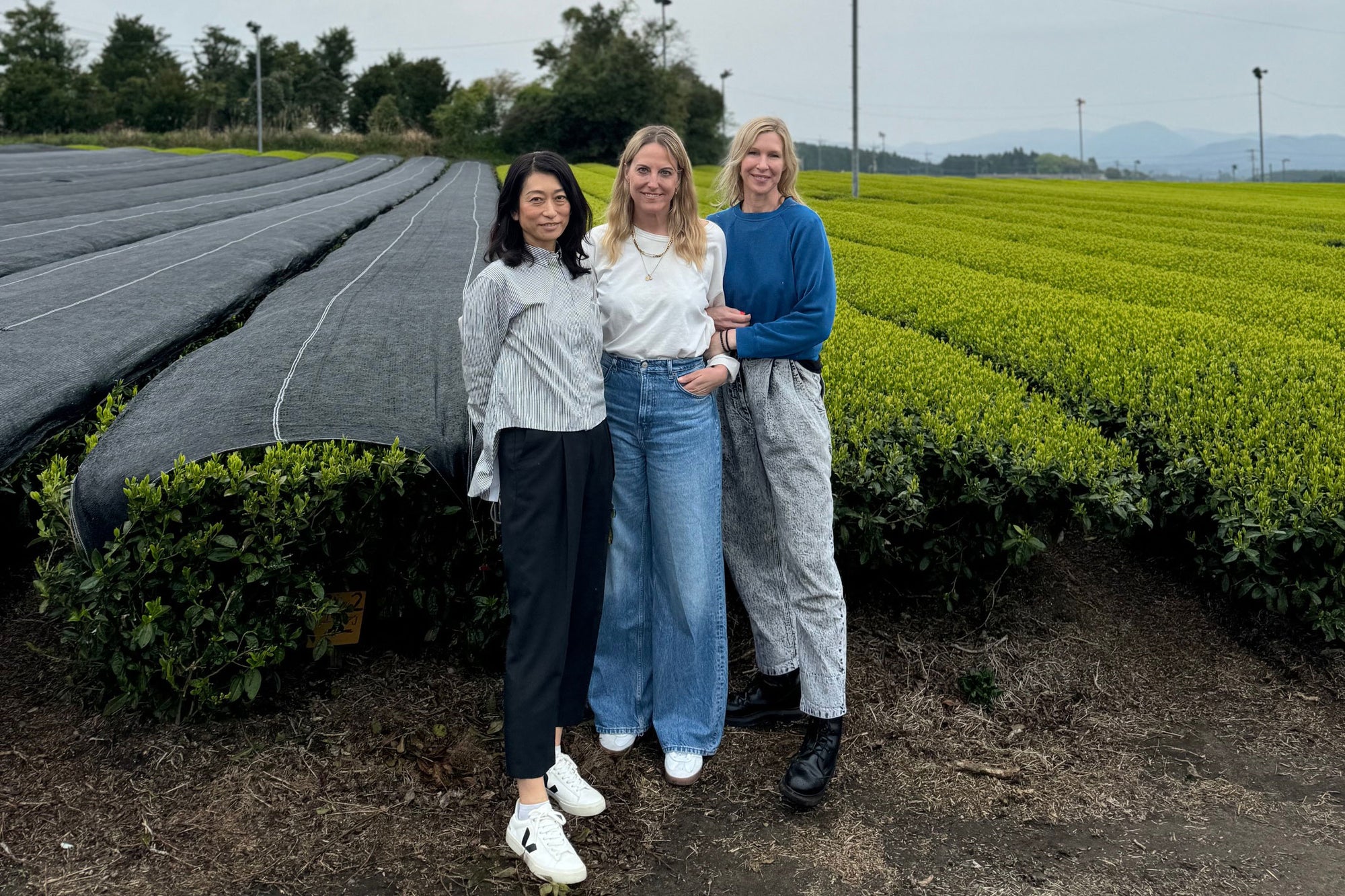

In search of the best Matcha
We have been drinking Matcha for years and almost all fans know this: If you love Matcha, then it's a really serious love. With passion in our hearts, we have built up an exciting knowledge of ground green tea. The more we have researched, tested and compared teas, the more differences, flavors and characteristics we have discovered over the years.
The taste often has something to do with the way the tea is grown, the way it is ground and, above all, the region where the matcha farm is located. So we flew to Japan to expand our knowledge, visit our matcha farmers and follow the harvesting process. We, that's Nina, Rei, Julia plus this time also Julia's kids and her mum.
There are two classic Matcha growing areas in Japan. One is the region around Kyoto and the other is in the very South of the main island around Kagoshima, a rather newer growing area. On a pretty rainy Tuesday, we met at Kitsuné in Kyoto to discuss our big goal over a Matcha (even with plant milk, which is relatively rare in Japan): to find the best Matcha.
What does "best Matcha" actually mean?
That is certainly individual for everyone. For us, the following points are particularly important:
- Taste: sweet, round, not too bitter, but smooth.
- Color: bright green. Not only as a powder, but also prepared as a drink.
- Organic cultivation: We drink our Matcha every day. Organic cultivation is therefore very important to us. We don't want any pesticides or chemicals in our tea.
- Aluminum: Teas are often contaminated with aluminum. This does not necessarily have anything to do with organic or conventional cultivation, but with the nature of the soil. It is therefore not only important to find the best Matcha, but also to test it in trustworthy laboratories. Incidentally, we did this with all our teas in order to find the best Matcha for you and us.

Our journey was by train about 1 hour outside of Kyoto and then on to a train that we particularly liked because it was tiny, had funny curtains and a great plant jungle pattern on the outside in the middle of the outskirts. There, our Matcha farmer picked us up in his Japanese minibus and drove us to the mountains of Uji. If we hadn't had our great colleague Rei with us, who is a native speaker, we really would have been "lost in translation". There was no chance of anyone here speaking a single word of English, which made the whole trip incredibly exciting and extremely authentic. That's exactly what Japan is - incredibly beautiful and actually similar to a movie set.
Our Matcha field is located in the middle of a mountain range, surrounded by two slopes. We were lucky because the sun came out for us for the first time in a week and the tea leaves reflected the light, creating a truly Zen moment. We learn all about cultivation, harvest time and the process of grinding.

This year the actual harvest is a little delayed as the weather has been unusually wet and cold for spring, our farmer explained as we drove back to his small, rustic office. On site, we tested his Ceremonial Organic Matcha, which he was one of the first farmers to start growing organically 30 years ago. This is still a rarity in the region and has not yet caught on with the masses. Our farmer prepared the tea with a super relaxed and calm vibe and we were immediately impressed. The taste is incredibly sweet, you can hardly taste any bitter notes or acidity. The taste unfolds like a warm hug. It was an incredible moment for us to be able to try this tea. And then in this beautiful setting.
After the region around Uji, our next stop was the south of Japan in Kagoshima. Here, too, we embarked on an exciting little journey into the Kagoshima hinterland. First by train and then by car around 1.5 hours deeper into the mountains of Kagoshima. The most beautiful nature unfolded around us - mountains, hills and tea fields upon tea fields. After many winding roads, we finally reached our Matcha field. We had already tried the farmer's tea beforehand and were absolutely thrilled. The tea is incredibly round and almost smooth. It was impressive to see the beautiful surroundings in which the tea grows and is harvested.
Here, around Kagoshima, many more of the bright green Tencha tea leaves are already sprouting. The weather is milder, and the mountain air favors growth. Some of the fields have already been covered with black tarpaulins so that the plant can continue to grow in the shade and thus store a lot of chlorophyll. It is precisely this miracle plant that we are waiting for and from which our matcha is made. All around the fields are large fans that move the cold night air upwards to protect the tea plant. Everything seems well thought out and highly professional in this country - we are impressed on all levels.
Back in Berlin, we are so incredibly excited to introduce you to our new matcha harvests. We have brought back an incredibly high-quality selection of matcha from Uji and Kagoshima. Both teas are probably the most intense Matcha flavor explosions we have tested on our trip.
As described above, we also had the teas tested for pesticides and aluminum in a lab here in Germany and they scored above average. This is just as important to us as the taste. This is not usual, as the tests are very expensive and time-consuming. For us, this is an absolute must and a standard that we don't want to do without.
